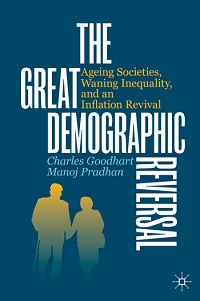The Great Demographic Reversal: Ageing Societies, Waning Inequality, and an Inflation Revival

Charles Goodhart and Manoj Pradhan
Palgrave Macmillan, London, UK, 2020, 280 pp., $24.40
The eminent Swedish economist Knut Wicksell (1851–1926) once argued that textbooks on economics should start with a chapter on population. A new book by Charles Goodhart and Manoj Pradhan echoes this approach, placing demographics and the influence of slow-moving and persistent trends on macroeconomic developments front and center in economic discussions.
The Great Demographic Reversal: Ageing Societies, Waning Inequality, and an Inflation Revival focuses on demographics and the participation of China in the global economy. It argues that the confluence of these two dynamic forces led—over the past three decades or so—to deflationary forces that explain falling inflation and nominal interest rates. These two phenomena also contributed to weak nominal wages, increased inequality in many countries, and social and political upheaval. Going forward, both forces will operate in reverse, leading to looming inflation pressure. The logic of the argument, in the body of the book, points to this plot playing out in the next three decades or so.
The authors acknowledge that, as of the beginning of 2020, they did not have a tight view of the timing of the coming inflection point. But COVID-19 changed everything, and they advance a very precise prediction: “…what will happen as the lockdown gets lifted and recovery ensues, following a period of massive fiscal and monetary expansion? The answer, as in the aftermaths of many wars, will be a surge in inflation, quite likely more than 5% or even in the order of 10% in 2021.”
Goodhart and Pradhan argue that the demographic reversal and the very expansionary monetary and fiscal policies put in place to combat COVID-19 will lead—sooner rather than later—to less saving and more investment. That will push the natural rate up. Financial markets and policymakers are unprepared for such developments. Accumulated leverage leads to financial fragility and discourages central banks from tightening, so inflation is bound to increase.
One year after COVID-19 was declared a pandemic, uncertainty remains elevated. Savings are high, and investment is weak. Workers are understandably concerned about their jobs and job prospects. Inflation has been low for years, and monetary policy has been under the shadow of the effective lower bound.
Loading component...
To my mind, Japan (with policy rates at or close to the zero lower bound for 25 years, a declining labor force since 1995 and falling population since 2008, and inflation averaged approximately at zero and expected to stay there for the next 10 years) is a clear counterexample to the inflationist thesis. But Goodhart and Pradhan disagree, and do so in a compelling way.
In fact, the authors include an engaging discussion of several objections to their main theses, which gives the book the feeling of a pleasant conversation with well-read and well-informed friends, prompting reflection and examination of conventional views.
Opinions expressed in articles and other materials are those of the authors; they do not necessarily reflect IMF policy.








